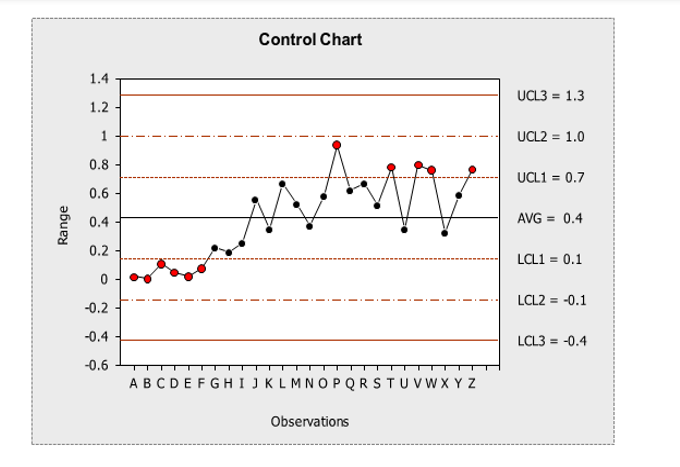
This article will provide a comprehensive examination of the tools and techniques utilized in Total Quality Management. Each tool will be thoroughly described, highlighting its role in improving quality, and accompanied by an illustration as well as examples of companies who take advantage of them. I will then give a summary of the key points that will be covered.
To ensure individuals perform tasks effectively in a quality environment, TQM tools are utilized. These tools aid in continuous improvement, problem-solving, and conducting evaluations. These instruments include: “Pareto Charts”, “Cause-and-Effect Diagrams”, “Histograms”, “Scatter Diagrams”, “Run Charts”, “Control Charts”, “Flow Charts”, “Surveys”, and “FMEA”.
Pareto Chart
What is a “Pareto chart”? This tool helps identify supplies based on their level of importance, distinguishing between those that are less critical and those that are more inconsequential.This chart can assist an organization in assessing the functionality of its supplies and identifying areas that require immediate attention. Microsoft Corporation used a Pareto chart to check and see what was causing a significant amount of errors and crashes in Office and Windows. The following shows an example of the Pareto chart. This shows the number of customer complaints the organization has obtained during the first 100 days of the year. As seen from this chart, it appears that the number of complaints has gone up by over 50%.

Cause-and-Effect Diagram
A “cause-and-effect diagram” not only associates but also identifies the reasons behind a certain issue.It envisions ways that different variables connected with certain procedures influence those procedures’ yield. This brings great contributions to quality management. The representation suggests that any organization should have a procedure in place to consistently progress, considering the entities depicted in this diagram. The “cause-and-effect diagram” is a good method for the food manufacturing industry. The example shows a cause-and-effect diagram displaying certain causes for the increase in complaints experienced in the first half of the year for the organization.

Histogram
A “histogram” projects recurrences regarding an event. Once the data has been analyzed, the chart can provide a new overview of the current procedural execution.The histogram helps one to see whether a procedure needs to be enhanced more unless another one should be introduced. A prominent financial website has an example of a histogram that explains the compensation of CEOs being distributed.The histogram below shows the percentage of complaints during the first 100 days, and it shows that it would have a normal distribution curve.

Scatter Diagram
A “scatter diagram” determines if there is a correlation between a pair of characteristics. It examines the connections between process variables and the characteristics of items flowing through a system as part of its contribution to TQM. A scatter plot by the NSW Ministry of Health was used to analyze the satisfaction of patients based on the period of consultation by a doctor. The next illustration shows a scatter diagram of customer complaints. Looking at the chart, it appears that the correlation is positive, but is not a strong positive one, which means the number of days has impacted the number of complaints, somewhat.

Run Chart
A “run chart” provides a comprehensive overview of the process’ yield outcomes over time.In terms of quality management, it can provide a visual representation of the activities taking place within a specific strategy for a specific period. Run charts were utilized by Koch Industries to keep up with operational costs.The run chart below shows a measurement of different parts. As expected, it appears that there’s an inclination, since there are a bunch of hurdles. A bunch of interesting things are going on with this procedure no doubt. And these are things that a quality representative could watch out for.

Control Chart
A “control chart” helps recognize basic, as well as compounded triggers. This chart contributes to observing certain approaches as well as supporting consistent enhancements. A steel company was able to save hundreds of thousands of dollars because of the use of control charts.
Pay close attention to the chart example and notice the data between the upper and lower boundaries. As one looks at this illustration, he or she is already noticing some changes within the quality-led process.

Flowchart
A tool that shows a realistic graphic for a certain strategy is a “flowchart”. This is used to start with developing the system. The flowchart assists quality representatives in managing, as well as progressing a method by seeing how it is currently functioning. One of the flowcharts by AT&T involved a particular ordering and quote process. The flowchart, as shown below, illustrates the current process for a customer service call center task. All the symbols illustrate what needs to be done from the start of the call to the end of the call or possibly transfer to a different department. Anyone from management can study this out to see if any improvements need to be made.

Survey
The “survey” is useful for acquiring significant data provided by individuals who more than likely won’t give out information in the first place. Consumers working for the company as well as outside the company can participate in this. These individuals do have the final say in terms of the value coming from the products and amenities of an organization. The company Starbucks uses this method to get feedback from customers on what needs to be improved or if they can offer any recommendations on brand-new products. The following image shows a fake example of a survey for Company A.

FMEA
FMEA is primarily utilized to identify and mitigate item-based or procedural malfunctions by assigning ranks to them. This tool assists a company with knowing the location of properties by functioning and associating basic catastrophic forms precisely. There’s even a software version of this. An example of this is shown below. Looking at the chart, there appears to be an analysis of what could happen when a certain malfunction impacts the way a process is implemented. Then later, there would be a decision on how to handle these malfunctions and the results of those decisions. Boeing uses documentation to discuss any issues if need be, regarding the FMEA procedure. For a while now, scientists have been utilizing this strategy incorporated with an easy-going rationale, keeping in mind the end goal- acquiring increased practical data. This rationale becomes an extremely fitting technique in terms of undertaking hazard appraisal, as well as managing vulnerability, along with a leadership that might be too soft. It seems that this is currently getting extremely critical. There is a necessity in making, as well as executing an organized/incline system regarding value control towards obtained products.

This discussion outlined the evaluation of total quality tools and techniques. It started with a brief introduction and then there was a focus on the overview, along with an outline of all the examples of TQM tools/techniques, a detailed description and contribution of each tool or technique, and finally, companies who have reaped benefits with these particular instruments. The following explanations should be very helpful to a quality team in understanding the importance of the devices used for total quality.
References
Amasaka, K. (2013). The Development of a Total Quality Management System for Transforming Technology into Effective Management Strategy. International Journal of Management,30(2), 610-630.
Excel Control Chart. (n.d.). Retrieved from http://www.databison.com/excel-control-chart/ .
FMEA. (n.d.). Retrieved from http://asq.org/learn-about-quality/process-analysis-tools/overview/fmea.html .
Goetsch, D. L., & Davis, S. B. (2016). Quality Management for Total Quality. Organizational Excellence: Introduction to Total Quality.
Lari, A. & Asllani, A. (2013).Quality cost management support system: an effective tool for organisational performance improvement. Total Quality Management & Business Excellence, 24(4), 432-451.
Measure3. (n.d.). Retrieved from http://thequalityweb.com/measure3.html.
Paciarotti, C., Mazzuto, G., & D’Ettorre, D. (2014). A revised FMEA application to the quality control management.The International Journal of Quality & Reliability Management,31(7), 810-788.
Roghanian, E., & Mojibian, F. (2015). Using fuzzy FMEA and fuzzy logic in project risk management. Iranian Journal of Management Studies, 8(3), 373-395.
Turof, TECHNICAL PROGRESS AS AN IMPORTANT TOOL FOR QUALITY MANAGEMENTM. (2014).. Economics, Management & Financial Markets, 9(1), 269-274.
Leave a Reply